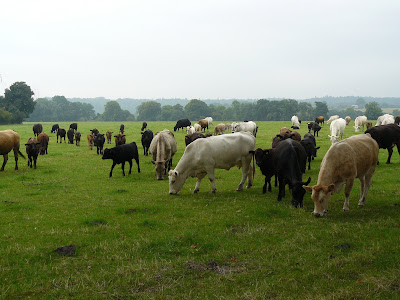This walk is courtesy of the National Trust, who own Hughenden, former home of Bejamin Disraeli. This Red Walk is one a series around the estate. It can be done separately from visiting the house.
The walk begins in the car park and leads quickly into beautiful beech trees of Woodcock Wood ....


Leaving the wood, the path goes across open fields and then enters Flagmore Wood and then Common Wood. Emerging from Common Wood, you take a short stretch of semi-suburban street before entering further woodland, emerging this time by the Disraeli monument, on a hill overlooking a valley and with Hughenden Manor visible on the other side.
The monument was erected by Benjamin Disraeli in honour of his father, Isaac D'israeli, a writer and scholar. Isaac changed the names of his children to make them seem less Jewish - and also had them baptised, which in due course allowed his son Benjamin to enter Parliament.
You then descend from the monument and climb the other valley slope to enter the grounds of Hughenden Manor, paasing to the south of the rear of the house, and round the side to pass the Victorian church and return to the car park. Four miles in all.
Map: Explorer 172 (Chiltern Hills West).
Rating: four stars. Some lovely woodland and views; interesting historical associations.

Hughenden Manor
Hughenden Manor was bought by Benjamin Disraeli in 1847, shortly after he became Member of Parliament for Buckinghamshire. He made major changes to the house and gardens, and lived there happily with his wife Mary Anne, as his political career flourished, becoming Chancellor of the Exchequer and then (twice) Prime Minister. He was made Earl of Beaconsfield in 1876, and in the following year entertained Queen Victoria at Hughenden.
The house and the estate were acquired by the National Trust in 1947. The interior of the house is much as it was in Disraeli's time, and many of the original contents remain. The formal garden, a terrace with attractive views around, has been recreated to reflect Mary Anne Disraeli's original design.














































